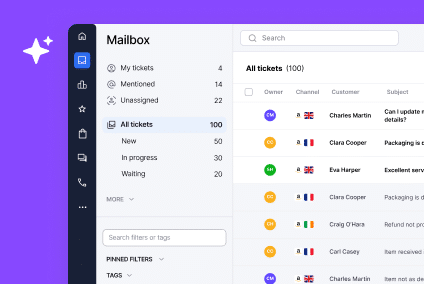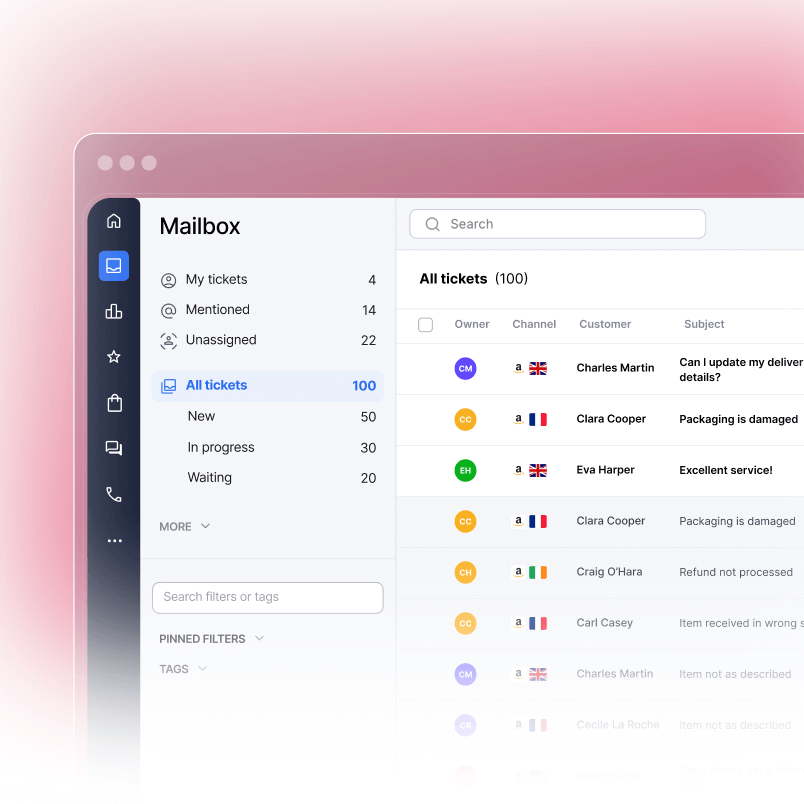What is AI for Shopify, and why should you care? In short, it connects the store data you already have with smarter tools that help you sell more, support faster, and work cleaner. If your team is juggling tickets, channels, and apps, AI for Shopify pulls it together so you can focus on growth.
In this guide, we’ll cover how to use AI Shopify integrations to power Shopify smart selling, from AI support Shopify that speeds up replies, to Shopify brand automation that keeps campaigns consistent, to Shopify customer AI that personalizes every step from browse to buy.
Why AI for Shopify matters right now
Your customers expect quick answers, accurate orders, and a checkout that feels effortless. And your team wants context, automation, and tools that don’t fight them. AI for Shopify closes that gap by using store data to personalize support, automate repetitive steps, and shine a light on what actually drives conversion.
This is about helping your team rather than replacing them. AI for Shopify removes the friction that keeps them from doing their best work. This means fewer tab switches, fewer copy-paste moments, and responses that already include the right order details. And it means agents open their inbox and see order status, past conversations, and warranty info already there. That’s the everyday win.
Shop Pay lifts conversion by up to 50% compared to guest checkout.
What “smarter Shopify integrations” look like
Here’s what brands mean when they talk about AI Shopify integrations in practice.
A single place to work from
Pull orders, messages, customer history, and team collaboration into one view so agents never start cold. You can centralize conversations in one inbox and action returns or replacements directly against the order, which keeps everything synced to Shopify. The result: less swivel-chair, fewer mistakes. With eDesk’s AI-powered Shopify integration, agents can see orders, issue refunds, and collaborate without leaving the inbox.
Shop Pay outperforms other accelerated checkouts by at least 10%.
AI that drafts, routes, and speeds up replies
Automated support can tag, triage, and assign tickets based on keywords or order state. AI-written first drafts give agents a head start, and translation handles multilingual questions without slowing anyone down. With AI-driven automations, teams get time back and keep quality up.
Teams can achieve up to 46% productivity with AI automations.
Content where you need it
Merchandisers and marketers can generate first-pass product copy and campaign snippets, then edit for voice. That keeps catalogs fresh and launches moving. When you’re shaping your stack, compare leading options across these AI-powered Shopify integrations to keep support and ops in sync.
Help for the team, not just the customer
New agents ramp faster, senior agents waste less time chasing updates, and managers can spot bottlenecks in real time. Collaboration tools loop in finance or ops without losing the thread. Less “who owns this,” more “it’s done.”
Real examples that move the needle
Let’s connect AI for Shopify to concrete outcomes you can measure.
Lift conversion at checkout
Use accelerated checkout, simplify forms, and reduce surprise friction. Pair that with proactive pre-sale support on key product pages so shoppers get answers before they bounce. A quick sidebar prompt on shipping or sizing often saves the sale.
Even the presence of Shop Pay can increase lower-funnel conversions by 5%, according to Shopify.
Recover revenue before it leaks
Automate outreach on high-intent signals. Start with first-time shoppers whose baskets sit above your median AOV, SKUs with tight margins, and checkouts that stall at shipping. Trigger a concise nudge or a shipping clarifier, then measure saved orders over seven days.
If you offer financing, surface it early. Installments can turn “maybe later” into “done” for higher-ticket items without training customers to wait for a discount.
Merchants using Shop Pay Installments have seen up to 50% higher average order value and up to 28% higher conversion.
Shorten first response and resolution times
Teams that lean into AI support in Shopify deliver consistent service at scale, even on peak days.
How? They auto-categorize issues like “where’s my order,” warranty requests, or size exchanges, then route to the right queue. They pre-fill responses with order numbers, tracking links, or return labels so agents can hit send with confidence.
When support, warehouse, and finance work from the same context, everyone moves faster. If live chat is part of your mix, keep it lean and connected to orders so agents aren’t chasing details; see best live chat apps for Shopify to align features with workflows.
Connect your store so agents can create draft refunds or exchanges from inside the ticket. That consistency reduces errors and stops double data entry.
Make product pages work harder
If your copy is thin or inconsistent, use Shopify brand automation AI to boost its impact. Generate a strong first draft, then add your brand voice and specifics. Fresh content helps search and reduces pre-sale friction, which eases the load on support. Keep a simple content cadence so new launches don’t bottleneck on writing.
A conversion rate above 3.2% puts you in the top 20% of Shopify stores.
How to roll this out without slowing the team
You don’t need a big project. Start small, prove impact, then scale.
Step 1: centralize support
Connect Shopify so orders, messages, and customer data sync into a single inbox. From there, agents can reply with full context, update orders, and keep threads tidy. That alone cuts handle time and errors. Point your team to the integration page so setup is a one-click job.
Step 2: automate the “boring but important”
Begin with two playbooks:
- Where’s my order – auto-tag, attach the tracking link, and suggest a reply that includes the carrier status.
- Returns and exchanges – auto-fill return rules and create a draft return or replacement against the order so the agent doesn’t retype anything.
Once those run smoothly, expand to pre-sale prompts on high-traffic pages, VIP routing, and multilingual replies. Let the team explore examples inside your automation library so they can self-serve and tweak.
Step 3: help agents help each other
When a thread needs input from warehouse or finance, use built-in collaboration rather than email. Keep it visible, time-bound, and tied to the customer. No lost context, no mystery delays.
Step 4: measure what matters
Track first response, resolution time, and deflection on common queries. Watch conversion from pre-sale chats and average order value for shoppers who interacted with support. Share quick wins with the team so they see the payoff, then iterate.
Here’s your recap and a roadmap
Remember this:
AI for Shopify connects the data you already have to the work your team does every day. Centralize the work, layer in Shopify predictive automation for the busywork, and let Shopify CX AI make every interaction feel personal. Let automation handle triage, routing, and first drafts so people can focus on judgment calls and empathy.
Add light pre-sale help on high-intent pages to remove blockers before checkout. Keep the loop tight with simple dashboards so you can see faster responses, higher conversion, and a lift in AOV without piling on admin.
Do these next:
- Connect Shopify to a helpdesk that centralizes orders, messages, and customer history in one inbox.
- Ship two automations first: where’s my order, and returns and exchanges.
- Add one pre-sale prompt on your highest-traffic product page; trigger on time on page or exit intent.
- Enable accelerated checkout and test it on your top devices and browsers.
- Track first response, resolution time, and assisted conversion for two weeks, then add one higher-leverage play.
Want to see eDesk’s AI-powered Shopify integration in action? Book a Free Demo for a tailored walkthrough.
FAQs
What is AI for Shopify in plain English?
In short, tools that plug into your Shopify store to automate tasks, draft replies, surface customer context, and remove friction in checkout and support. You choose where it applies.
Will AI replace my agents?
No. It speeds up drafting, routing, and data lookups. Your team still approves replies, makes judgment calls, and builds relationships.
Can AI handle refunds in Shopify?
Yes. Set rules to draft refunds or exchanges against the order, then let agents approve. That keeps policy consistent and removes retyping. Start with low-risk cases like duplicate orders or instant returns on unworn apparel.
Do I need dev time to set this up?
Not to start with. Connect your store, choose prebuilt playbooks like “where’s my order”, then tune rules. Add workflow tweaks later if you want deeper routing or custom tags.
How does this help conversion, not just support?
Proactive pre-sale help answers questions that block purchases, and accelerated checkout clears the last hurdle. AI for Shopify ties those moments together so shoppers keep moving.
What if my catalog changes a lot?
Use AI to draft product copy, then edit for voice and accuracy. It’s faster than writing from scratch and keeps pages fresh for both shoppers and search.




